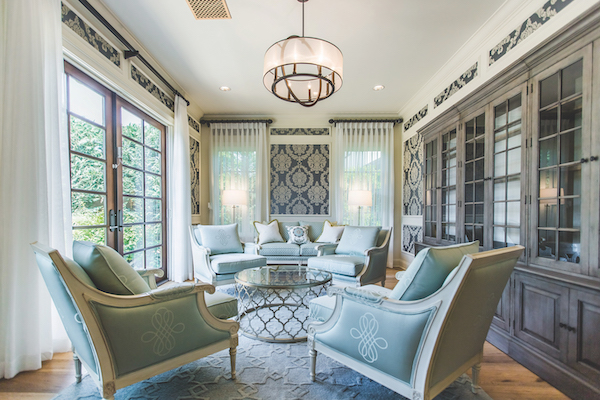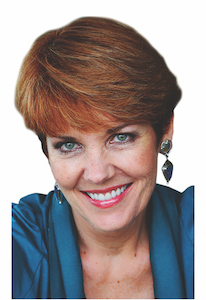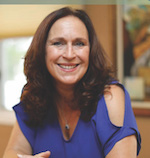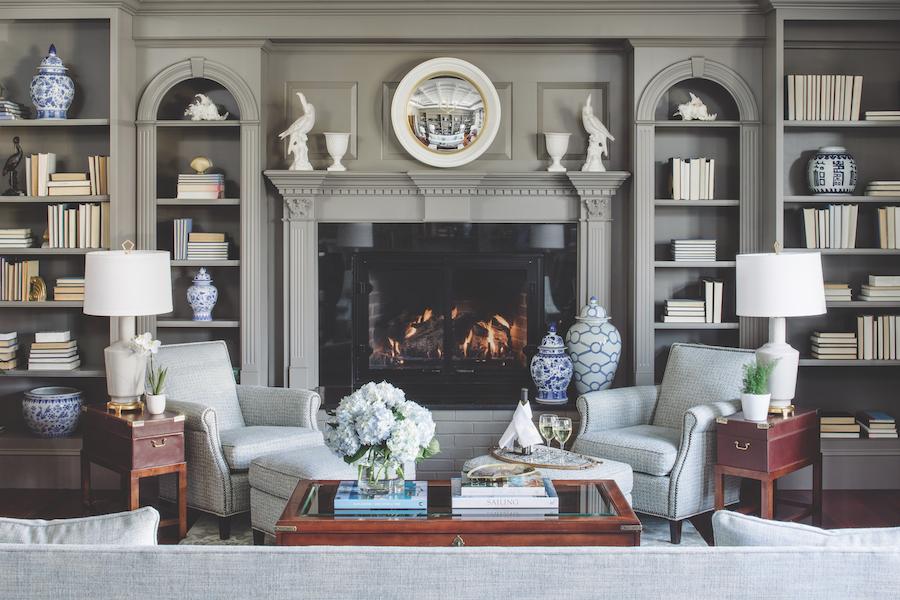For interior designers and retailers in the home design business, much of their success hinges on the ability to brand themselves in a way that connects with clients and carries through all of their projects and retail transactions. In our most recent Home Design Business Think Tank, Furniture, Lighting & Decor spoke with business coaches Melissa Galt and Nancy Ganzekaufer on best practices for developing your business brand messaging and communicating that to clients and potential clients. We then followed up with first-hand accounts from designers and retailers who have a handle on their brands and have seen success as a result. First, you need to understand who you are and what you bring to the table that resonates with your ideal client. Second, what makes you happy? From there, messaging communication is about consistency and authenticity. We’d like to thank Kichler and Las Vegas Market, our sponsors for the spring Home Design Business Think Tank.
Let’s Get to Know Each Other
When you first encounter interior designer Goff Christian, you know what you’re getting and where you stand from the first interaction. Christian’s approach to home design is one of “Let’s get to know each other, and we’ll go from there.” He knows who he is, he takes the time to understand his clients, and his brand is uncomplicated and true to his vision.

Christian prides himself on building his relationships on authenticity. “People are always attracted to other people who are comfortable in their own skin,” he says, noting that 90 percent of his new clients are referrals from existing or past clients. “I come with testimonials,” he laughs.
Part of making clients feel at ease with him and his design services, Christian adds, is a sense of transparency. When working with new and existing clients, he says, what you see is what you get. “I’m diligent about my routine, and routine is what clients are excited about,” he says,” adding that he strives for no surprises. “All of my invoices actually show what my markup is. People want honesty and service. If I went somewhere, I’d want the same.”
Christian has headed his own design firm for the last three and a half years, but design, interior and otherwise, has always been at the forefront of his lifestyle. He lived most of his formative years overseas where he developed his penchant for texture and ethnic design. “Bringing in unique pieces makes a space more personal,” he says, noting that he focuses on adding cultural pieces to clients’ decor. “I lived it, so I can communicate it.”
And while his global background accounts for much of his design style, Christian also has an architectural degree, which helped him forge his design destiny. At one point in his career, he took on the design of a presidential palace in Africa. During that time, however, Christian endured a year-long recovery period from malaria, which was an “eye-opening experience,” he says. “I look at everything as glass half full, so I began to think about what it was that I really wanted to do,” he says. “All I wanted to do was paint, be an artist.” He began by painting people’s homes, which led to moving furniture around to help with balance. He ended up being hired by Ethan Allen, where he worked closely with “design” clients for many years. As he moved frequently with his husband’s job, he eventually became a trainer for the organization.
On the last stop, California, where Christian resides now, he realized, “I need to do me,” and decided to retire to “do his own thing.” It didn’t take long for his “own thing” — Goff Designs — to take him right out of retirement.
“I take care of my clients like I’m their concierge,” says Christian, sharing that one of the first things on the list is understanding their tastes and lifestyle. “It always helps to get to know each other’s personalities,” he says.
Once that’s achieved, Christian stands by his design aesthetic, which is “an eclectic but streamlined look.” To ensure that “couture experience,” Christian will often infuse something designed just for that client. “I’ll design something from scratch,” he says. “I’ll design furniture, pillows, upholstery, artwork, so they have a one-of-a-kind Goff original.”
When sharing on social media and through other marketing outlets, Christian focuses on transparency. “I want to show myself as a person who is showing beauty everywhere I go,” he shares. “I post pictures of parts of the project and make comments that show more about me.”
On Christian’s design website, you’ll notice that his logo is simply a script G. “I like it because it’s simple,” he says. “A scripted G is more my personality. People know me now because of that G. I sign everything that way, even my artwork.”
For Christian, design is about doing something that makes him happy, and in turn, makes his clients happy. His brand message and communication style is simple, like his logo. “Let’s just play in my sandbox. Let’s have fun and create something.”
A Bountiful Progression
Jamie Merida’s journey to home furnishings retail, interior design and product design was anything but straightforward. His parents were antique dealers, a good foundation for understanding home and style. Before delving into that business, however, Merida was a classical pianist and subsequently ran several busy Domino’s pizza franchises.
As his parents were approaching retirement, he left the frenetic pace of Domino’s and accompanied them to help them divest of the antiques business. “Short story, I began making my living from antiques shows, but I’d accumulated more than I could fit in my truck.” Merida opened his first retail space in 1997 and continued on the show circuit until the early 2000s. That first location was in Naples, FL, and was called Bountiful Home.
Bountiful Home didn’t stay strictly antiques for long, as Merida realized adding gifts, accessories and home furnishings helped to boost revenue. He eventually opened a second location in Easton, MD, which is now Bountiful’s home location.
Bountiful now encompasses a bevy of businesses: an expansive home furnishings store (Bountiful Home), a flooring store (Bountiful Flooring), interior design services (Jamie Merida Interiors), and Bountiful Home product lines designed by Merida for Chelsea House, Wildwood and more. “Bountiful Home is a reflection of who we are,” Merida says of his focus on what he calls casual elegance. “The style at Bountiful is traditional made modern.” Merida has carried this aesthetic through the branches of his business as he has expanded into interior and product design. He notes, however, several years ago, his then marketing person told him, “You can’t build a brand without your name in there.”
As a result, he’s added his name to the interior design side of his business and he’s infused himself into his social media, marketing and client outreach. Social media has given Merida the platform to put himself out there alongside his Bountiful brand and connect the two. “Social media helps us sell and broaden the brand. I have people who want to get their picture taken with me,” he says. “People who follow us on social media want to know that we planted 350 impatiens in the garden.”
Social media interaction has also helped Merida to bring the businesses together. “A lot of people who follow our design social media come in for that but didn’t know about the retail shop,” he notes. “Then they become retail customers.”
Most important to Merida’s brand is authenticity. “If you’re going to do this you have to be genuine,” he says. “You have to be good at the nuts and bolts of it. You also have to be able to clean the toilets, make the deliveries. That’s how you make a successful business.”

Expert’s Top Tips: Connecting with Clients, Customers
Business coach and author Melissa Galt shared her top tips for communicating with clients and customers throughout the sales/project process in a way that builds a relationship, gives consumers the confidence to trust you and elevates your brand. Learning to listen is key, says Galt. Read on for her tips throughout the process of working with a client or customer.
For more on Melissa and her coaching business, visit www.melissagalt.com
Upon First Meeting
When introduced to a design client or retail customer, Galt says “It’s not about you, it’s all about them.” Find out what brought them to you, what their needs are and listen for points of connection. Learn about their lifestyles and find connection points through conversations that build a relationship and help you understand some of the factors that may influence their decision making.
“You need to be really genuine in this,” Galt adds. “When you get [customers/clients] talking, it no longer feels like you are trying to sell them something. Customers and clients that feel seen, heard, understood and cared for will buy up to five times more from you.”
“Stay in control of connecting, communicating and following up,” Galt shares. Instead of giving out your business card, get a potential client’s contact information so you can follow up with them instead of relying on them to reach out to you.
Communication Throughout the Process
Getting Started. Ask your client what’s the best method of communication for them, says Galt, be that email, text or phone calls. Don’t assume, based on “wisdom,” that your Millennial client will want to text only. If it’s phone conversations your customer wants, whenever there are decisions that have been made or possible changes, follow up with email so you and your client have a written record. Use bulleted lists for quick review and have your clients initial the documents if possible. “It gives you a really thorough set of notes.”
During the Process. Have a weekly touch point with every active client that you have. You pick the day, the time and how to connect, Galt advises, but adapt your communication to the client’s preferences. The weekly touchpoint, especially during waiting periods, gives your client confidence and eliminates outreach from them to you.
Stay in Touch. The job is done, the client is happy and you move on to the next client. However, don’t forget to stay in touch. “The relationship is a priority always,” says Galt. Reach out to previous clients on a regular basis, “not to sell but to ask how you are in this crazy time we’re in, what’s going on with you?” Galt adds that you should check your files first so you understand what the client’s need might be. Know the backstory. Above all, “be compassionate, caring and willing to listen.”

Expert Tips: Crafting Your Brand Message
Business Coach Nancy Ganzekaufer shared her top tips for defining your brand message in a way that connects with clients and potential clients. Here are her top takeaways. www.nancyganzekaufer.com
Know Your Ideal Client. If you are talking to everyone, you are talking to no one, says Ganzekaufer. “Niche is rich, and broad is broke.” Develop a niche that focuses on a defined segment of clients, a style or product expertise. You’ll be speaking to a core group of people who will hear you, she says. That doesn’t mean you can’t expand. “When you’re really clear on your messaging, other customers will come to you,” Ganzekaufer says, because you’ll come across as knowledgeable and have confidence in your brand messaging.
Your Business in Words. Define your business and what you can do for your clients in four sentences. This can take time to cultivate, but you’ll know when it’s right, says Ganzekaufer. Those four sentences?
- Define who you are and who you serve using three adjectives and your title.
- Make this sentence about your clients. What do they need and what will you do for them to fill that need?
- Share your process. Help your potential clients visualize working with you from beginning to end. Be concise and clear.
- Share what it is about what you do that makes you happy. Your enthusiasm will shine through.
Get the Your Business in Words worksheet on the website.
You’ll be sharing your brand message across multiple platforms. It takes seven to 15 touch points before a consumer is comfortable making a luxury purchase. Interior design services and most home furnishings would be considered luxury purchases.
Be Visible: Brand messaging is being authentic. People want to know who you are and what you can do for them. Make sure your picture is on your website, your social media and anywhere else you might make a connection. Share testimonials humbly and truncate them for effectiveness.
Be Consistent: Wherever you connect with your potential clients, be sure your message is consistent.
Know Who You Are: A clear message is a confident message. If you know who you are, your customer will feel confident hiring you.







